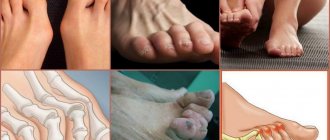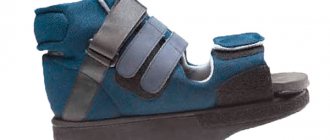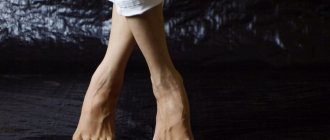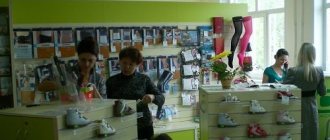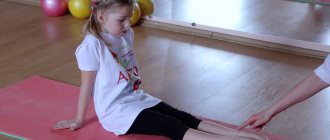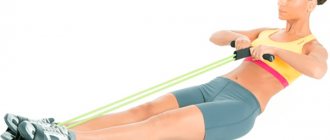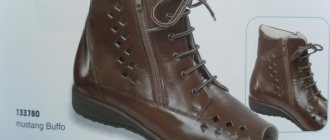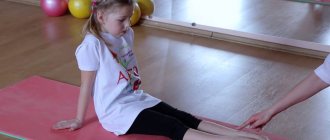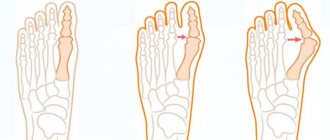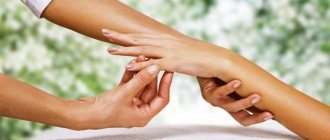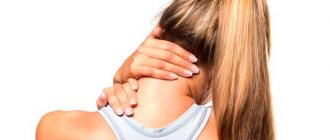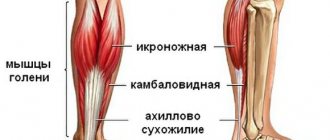A set of exercises for feet with hallux valgus in a child
Category: Teaching materials Date of publication Author: Timoshenko Natalya Gennadievna
A set of exercises for feet with hallux valgus in a child
- Additional recommendations
characteristics of the disease
Foot valgus is a foot deformity in which the heel and toe area are deviated outward. In this case, the curvature itself is internal in nature, and the arch of the foot is significantly reduced. Children suffering from hallux valgus quickly get tired while walking, have an abnormal gait, and their lower limbs are X-shaped. In addition, a child suffering from this pathology is especially prone to developing flat feet, arthritis, arthrosis and various types of joint deformities.
According to experts, a small patient’s foot can become deformed as a result of weakened muscle ligaments, traumatic injuries, rickets, polio and other unfavorable external factors.
In addition, hallux valgus can also be congenital in nature, in which the baby’s foot becomes bent during the period of intrauterine development, which is usually associated with a complicated pregnancy.
However, whatever the reasons, it is necessary to combat hallux valgus in children. In most cases, doctors recommend techniques such as massage and physical therapy exercises for these purposes.
Deformation degrees and diagnostics
Deformity of the hindquarters with a planovalgus foot is classified into four stages. The main indicator is determined by the alignment of the heel to the axis of the shin:
- Stage I - slight deviation: 10-15°. There is flatfoot, but without deformation or pain. Tenosynovitis is sometimes observed. Corrected by selecting special shoes and exercise therapy;
- Stage II - the angle is 15-20°. The difference from the first is the already noticeable deformation of the calcaneus and talonavicular joint, which can be reduced manually. Treatment includes conservative therapy. In rare cases, the doctor uses medial osteotomy methods and Cotton surgery;
- Stage III - exceeds the norm by 20-30°, is eliminated with the help of fixation. Complex and conservative therapy is carried out. The doctor may prescribe a three-joint arthrodesis;
- Stage IV - deviation from the norm is more than 30°. In addition to the foot, the ankle joint also suffers. The radiograph shows deltoid ligament incompetence with significant lateral inclination of the talus. Surgical intervention is used.
What are the benefits of therapeutic exercises for hallux valgus?
Specially designed physical exercises for valgus feet are an integral element of complex therapy aimed at combating this disease.
Physical therapy is especially effective in the treatment of hallux valgus in young patients. This is due to the fact that the child’s bone, cartilage and joint tissues are soft, elastic and very amenable to correction. Note that positive results can be achieved with a regular and systematic approach to classes.
Of course, the younger the patient, the easier it will be to correct the existing deformity.
A therapeutic course of physical and gymnastic exercises for hallux valgus allows you to achieve the following therapeutic results:
- elimination of pain;
- relieving the feeling of heaviness and discomfort localized in the lower extremities;
- gait correction;
- prevention of further progression of the pathological process;
- prevention of the development of flat feet and other complications characteristic of valgus;
- strengthening ligaments and muscle groups;
- correcting the shape of the foot and giving it anatomical correctness;
- normalization of blood circulation processes in muscle tissue structures;
- elimination of swelling.
For maximum effect, experts recommend that parents visit the physical therapy room with their child at least twice a week, and work with their child at home every day. In this case, the positive results of gymnastics will not take long to arrive and will be stable.
Basic set of recommended exercises
Gymnastics for hallux valgus is aimed primarily at strengthening the muscle groups of the foot. For young patients, the following simple but very effective exercises are especially recommended:
- Walking alternately on your heels and on your toes (especially effective for deformed big toes).
- Draw a straight line with chalk and ask the child to walk along it several times (for older children, you can also use an “imaginary line”).
- Flexion and extension of fingers.
- Squats.
- Tilts towards the foot. In this case, the small patient’s leg should be as straight as possible.
- Walking on the outer edge of the foot. In this case, the foot should be slightly turned out.
- Stroking the surface of the other leg with one foot.
The exercises presented above constitute a basic, elementary complex that should be performed daily, devoting 1.5-2 minutes to each exercise. Such gymnastics can be used not only for therapeutic purposes, but also for preventive purposes (in particular, to prevent the development of flat feet).
Additional exercises
The following set of gymnastic exercises for hallux valgus is somewhat more complicated, but with the help of parents even the smallest patient can master them:
- Have your child sit cross-legged. Take his hands. Next, the baby should slowly rise and fall to the floor. After several passes, you will need to repeat the exercise, changing the leg lying below.
- Invite your baby to lie on his back and place his hands on the floor. Place a small ball between your child's feet and ask him to throw the toy to you using his feet. As a rule, children really like this game.
- Place a handkerchief on the floor and ask the child to collect it using only his toes.
- Invite your child to lie on his back and use his legs to move as if he were riding a bicycle. The required number of repetitions is from 10 to 15.
- Ask the little patient to pretend to be a fan, spreading his toes as wide as possible. It is recommended to repeat the exercise about 10 times.
- Place the child on a chair, place a small rubber ball under his feet and ask the child to roll the toy with his feet. The optimal duration of the exercise is 5 minutes.
- Invite your child to play clapping, but only clap with their feet rather than with their hands.
- Sit the child down and ask him to bring his feet together. Repeat 10 to 15 times.
- Place a wide stick on the floor and ask the child to squat while standing on this stick. The recommended duration of this exercise is 3 to 5 minutes.
- Ask your child to lie on his back, stretch his legs forward and bend them alternately at the ankle joint. You need to do 10 repetitions with each leg.
Experts recommend performing this set of exercises twice a day, and to achieve the maximum therapeutic effect, it is advisable to give the little patient a foot massage.
Carrying out a massage
The main treatment for foot deformities is exercise therapy and massage. The same exercise therapy complexes are used for children with cerebral palsy.
Massage helps restore muscle tone in the lower back, buttocks, legs, and prevents possible rupture of the medial disc.
It is performed gently, massaging the lumbar area with two palms. The hips are pulled up with the hands and tilted. Massage is very important and necessary.
In order for your child to develop normally, it is advisable to start massage from the age of 1.5 months. Add developmental exercises and hardening.
The massage is performed by a specialist or parents after a training course. Exercise therapy is added when the child is already well on his feet (in the presence of flat valgus, it is necessary). Typically the massage course lasts 1 month. Then follows a break of 3 weeks. Then you can repeat the course.
Performing a massage:
- We place the baby with his stomach on a table or hard sofa so that his feet hang down. We place a cushion under the shins.
- We begin to stroke the back from bottom to top along the spine, then to the sides.
- Knead, rub the muscles with your fingertips. We stroke, knock with the edges of our palms or bent fingers. Gently stroke.
- We massage the lumbar area in the same way: stroke it, rub it down and to the sides.
- We also stroke the buttocks, knead them, pat them, and finish with stroking.
- Manipulations with the hips are also constant: from the knee upward we do rubbing and stroking.
- We massage the back of the lower leg more carefully. First, gently stroke from the bottom to the knee hole. We thoroughly knead the outer part of the muscle, stretch it, trying to relax it. Internal – vigorously, deeply knead.
- We massage the foot by turning it inward with the sole. We smoothly iron it, then rub especially its inner edge.
- We place the baby on his back and place a bolster under his knees. We stroke, shake, rub the legs, move on to the hips.
- Massage your shins from bottom to top. We stretch the ankle in a circle. We rub the inside of the ankle especially carefully.
- With one hand, gently rotate your baby's foot inward. With the other palm, massage.
Worth noticing! During massage, different techniques are used. The main ones are stroking and warming up with spread fingers. Direct more impact on the area of the child’s big toes and the inner sides of the feet.
About the health benefits of walking
Race walking is an important point in the fight against hallux valgus in children. Moreover, it is recommended for children to walk on embossed, uneven surfaces. For these purposes, parents of young patients will need to purchase a special orthopedic mat. But you can cope with the task on your own by simply sewing large buttons onto the fabric.
In the summer, try to have your baby walk barefoot on grass, sand or pebbles as much as possible. If you are relaxing at the seaside, then collect as many pebbles as possible; they will be useful for giving your child warm foot baths with the effect of additional stimulation.
In winter, you can simply scatter peas or cereals on the floor of the apartment and invite your baby to run around on them. All this will contribute to the maximum strengthening of the muscle groups of the foot, increases the sensitivity of the feet, in addition, the effectiveness of physical therapy will help to significantly speed up the healing process.
How to do gymnastics
The main rule in therapeutic exercises is regular and systematic exercise. However, explaining to a small child the need for classes can sometimes be very difficult. Therefore, try to captivate the little patient with the process of physical therapy by conducting classes in a fun way. Many children imitate their parents, so the child will be much more willing to study with mom or dad, repeating the exercises after them.
Try to add maximum variety to your classes, periodically changing the exercises; this is important so that the little patient does not get bored with gymnastics. If the baby is really tired, it would be advisable to stop the training and continue it a little later.
Additional recommendations
Despite the high rates of effectiveness and efficiency of therapeutic exercises, exercises alone may not be enough to completely overcome hallux valgus in a child, especially if the disease is in a severe, advanced stage. The following extremely simple recommendations will help speed up the recovery process:
- Choose high-quality, comfortable shoes with orthopedic insoles for your child.
- Give your baby warm foot baths with the addition of pine needles or sea salt. Such therapeutic procedures help eliminate tension in the muscle groups and ligaments of the foot.
- Combine physical therapy exercises with foot massage, which is recommended to be done regularly.
- When creating a set of exercises, be sure to consult a specialist about this.
- Sports such as swimming and wall bars have a good effect.
As for the prevention of this disease, competent pregnancy planning and regular visits to a specialist while expecting a baby will help prevent the development of hallux valgus in a child. In addition, it is not recommended to start raising a baby who has not yet reached the age of eight months. Monitor the child’s weight and development: extra pounds, as well as insufficient body weight, are also factors that provoke the development of hallux valgus.
When to expect positive results?
With a systematic approach to physical therapy exercises and strict adherence to the recommendations of specialists, the first results become noticeable after a week’s course. It is easier for babies to walk, pain and discomfort are eliminated. It is difficult to determine the duration of treatment, since it depends on the stage of the pathological process and the individual characteristics of the baby.
The most pronounced results from therapeutic exercises for feet with valgus are achieved after a year of regular, systematic exercise.
Therapeutic exercise for valgus in children is a time-tested, effective technique that allows you to eliminate signs of deformity and stop the further development of the pathological process. To achieve extremely favorable results, it is recommended to combine gymnastics with therapeutic massage and wearing orthopedic shoes.
Prevention
Any disease is easier to prevent than to treat. If you follow simple rules, you can avoid deformation of the lower extremities.
- Do not deliberately put the baby on his feet too early (before eight months of age).
- Choose shoes that fit, don’t wear someone’s old shoes.
- Do not wear shoes with narrow toes and heels.
- Walk barefoot not only on a flat floor, but also on pebbles, hummocks, and sand. A massage mat with convex elements, as well as a wall bars, are also suitable.
- Monitor the child’s weight and prevent the development of obesity.
It must be remembered that the sooner hallux valgus deformity is identified and exercise therapy begins, the greater the child’s chances for a favorable outcome. You should not leave the treatment process to chance; competent orthopedists and exercise therapy instructors will always tell you how to properly organize classes and prescribe additional therapeutic techniques.
